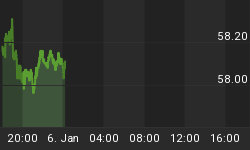Hooray! On March 17, the widely-followed University of Michigan Consumer Sentiment Index hit a 17-year high.
The Fed and most of mainstream media believe consumer sentiment relates to consumer spending. It's one of those beliefs that is bandied about that no one seems to have thoroughly investigated.
Last week, John Hussman posted an interesting chart comparing consumer sentiment to the stock market. But let's dive deeper. Specifically, let's see how sentiment does or doesn't relate to retail sales.
To kick off the discussion, consider a set of interesting quotes by Fed Chair Janet Yellen, Bloomberg Econoday, and John Hussman on consumer confidence.
Janet Yellen: "Household spending continues to rise at a moderate pace, supported by income gains and by relatively high levels of consumer sentiment and wealth." The quote is from the FOMC Press Conference on December 14, 2016.
Econoday: "The consumer sentiment index, which unlike other confidence readings had been edging back slightly, is once again showing increasing strength, at 97.6 for the preliminary March reading vs February's final at 96.3. The gain is centered in the current conditions component which rose 3.0 points to 114.5, a 17-year high and offering an early hint of strength for March consumer spending." The preceding quote from Econoday on March 17, 2017.
John Hussman: "Multi-year highs in consumer confidence are less a sign of forthcoming consumer spending as a sign of forthcoming investor losses." That quote is from a Hussman Tweet on March 9, 207. His chart follows.
Consumer Confidence vs. S&P 500

I added the verticle bars. Clearly, sentiment correlates well with the S&P 500, but how does it equate to consumer spending?
Consumer Sentiment vs. Retail Sales

As you can see, retail sales keep marching higher and higher, slowing or stalling only in recessions. This is not an accurate comparison because the population is constantly growing.
I will adjust the chart in a moment, but first, let's consider the population effect.
Total US Population

US Population Percent Change From Year Ago

The impact of population growth is one of the factors that affect sales growth.
But age itself is a factor. The spending habits and needs of someone of age 3 are far different from someone age 13, 23, 43, 63, or 83.
Nonetheless, we can make a crude adjustment to retail sales by factoring in population changes.
Sentiment vs Retail Sales Percent Change Minus Population Percent ChangeÂ

If that chart suggests anything, I sure don't know what, other than volatility in sentiment is far bigger than volatility in retail sales.
Let's  adjust sentiment volatility by a factor of six to see if that helps.
Sentiment/6 vs Retail Sales Percent Change Minus Population Percent Change

That chart looks like statistical noise. Sometimes the directions match sometimes they don't. Perhaps month-to-month correlations are simply too frequent.
Population Adjusted Retail Sales vs Consumer Sentiment Percent Change From Year Ago

Let's hone in on that for an amusing look.
Population Adjusted Retail Sales vs Consumer Sentiment Percent Change From Year Ago - Detail

Modern Day Snake Oil
I was discussing economic indicators with Pater Tenebrarum at the Acting Man Blog a couple of days ago. He pinged me with the correct takeaway.
Economic forecasting is not a science, and it is actually not the task of economic science to make forecasts (contrary to what is commonly asserted). Forecasting is akin to the task of the historian. Mises called speculators "historians of the future".
Economic laws only play a role insofar as they can be used as constraints for a forecast. The problem is that all these models simply look at the data of economic history, at statistical series that always turn tail "unexpectedly", driven by human action.
All these mathematical models are complete humbug. It is modern-day snake oil.
Politics vs Sentiment
The above charts are sufficient to prove the snake oiliness of equating sentiment to spending as a predictor of anything.
The story gets even more amusing if you dive into further details of the University of Michigan survey.
The overall level of consumer sentiment remained quite favorable in early March due to renewed strength in current economic conditions as well as the extraordinary influence of partisanship on economic prospects. The Current Economic Conditions component reached its highest level since 2000, largely due to improved personal finances. While current economic conditions were not affected by partisanship, this was not true for the component about future economic prospects: among Democrats, the Expectations Index at 55.3 signaled that a deep recession was imminent, while among Republicans the Index at 122.4 indicated a new era of robust economic growth was ahead. Interestingly, those who self-identified as Independents had an Expectations Index of 88.3, which was nearly equal to the midpoint of the partisan difference. Importantly, there was no moderation in these extreme views from last month, with the maintenance of the partisan divide fueled by selective attention to economic news, with Democrats more frequently reporting unfavorable developments and Republicans more frequently hearing of favorable changes. Overall, the sentiment data has been characterized by rising optimism as well as by rising uncertainty due to the partisan divide. Optimism promotes discretionary spending, and uncertainty makes consumers more cautious spenders. This combination will result in uneven spending gains over time and across products.
Look Ahead Index of Sentiment
-
Democrats: 55.3 Supposedly this signals "a deep recession is imminent."
-
Republicans: 122.4 Supposedly this indicates "a new era of robust economic growth is ahead."
-
Independents: 88.3 That is "nearly equal to the midpoint of the partisan difference."
Conclusion
Sentiment suggests a deep recession within a new era of economic growth in which nothing much at all happens. Economists believe consumer spending will follow.
Inquiring minds may also wish to consider another statistical idea: Rogue Nowcasts: 67% Chance Both are Wrong
















